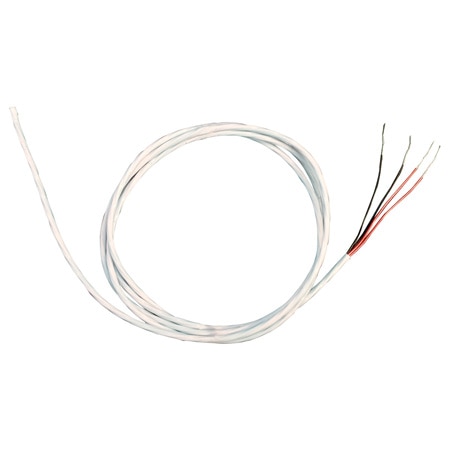Welcome to our new website, found an issue or bug? Please report it here

HSRTD
FLEXIBLE SEALED PFA RTD SENSOR, ROHS
Models In Stock
- 100 Ohm, Class “A” or “B” DIN Platinum Thin Film Element Standard, 1000 ohm Resistance Also Available
- Sealed Against Moisture and Corrosion
- PFA Insulated Cable
- Temperature Range: -60 to 260ºC
HSRTD
From
$
59.61
Models In Stock
Product Overview
- Insulation PFA
- Process Temperature, Max 250 °C
- Process Temperature, Min -60 °C
- Temperature Sensor Type RTD
- Tip Diameter 3 mm
- Wire Gauge 26 AWG
- Wire Type Stranded
The HSRTD Series Flexible RTD Temperature Sensor Probes are hermetically sealed at the sensor tip to provide continuous protection at the temperature measurement junction. The flexible sensor probe PFA cable forms a hermetic seal and electrically isolates the small RTD sensor, suited to a variety of applications.
For a hermetically sealed Thermocouple sensor, see the HSTC
For a hermetically sealed Thermocouple sensor, see the HSTC
Accessories
3-Prong Mini flat pin Connector for Thermocouple, RTD and 3-Wire Thermistor
$5.76
239 In Stock
Show Ratings & Reviews
Rated 4 out of
5
by
PROVE IT from
Resistant to magnetic flux change
I have probably purchased 30 of these over the last 5 years. They perform much better than bimetallic thermocouples for reading temperature in magnetic induction applications. The durability is good, but not outstanding in harsh environments, especially in steam at temperatures greater than 120°C (thus the purchase of 30 over the last 5 years). Their response is faster than metal clad RTDs. The rapid response allows for more contained PID controll. It would be wonderful if Omega made a steam-tolerant packing gland for the RTD where the RTD tip was not in contact with a metal (as is the case in a thermowell).
Date published: 2016-07-01
Rated 5 out of
5
by
BMJa from
RTD Probe
The RTD probe arrived quickly and is as described. The materials seem high quality and it performs as expected.
Date published: 2025-01-22
Rated 5 out of
5
by
jricha00 from
Durable and easy to use
I use these to measure the temperature on the backside of PV modules. The RTDs are easy to use and they are very durable. The pre-tinned wire leads make installation very easy.
Date published: 2020-09-14
Could this RTD sensor measure at temperature for -80°C? I mean would it damage the sensor at -80°C? Let say if I gonna purchase & send to calibration lab for -80°C calibration and obtain the correction factor for this particular temperature to use this.
Hi CL Lee,
Thank you for the inquiry. The materials are verified to -60 C. I would suggest to test at your target temps for a period of time before investing in calibration for offsets.
Best regards
OMEGA
Date published: 2023-05-16
What is the self-heating coefficient of the 1000 ohm varieties? Also, does the excitation current of the CN32PT readouts change with the 100 ohm vs 1000 ohm RTDs?
Thank you for your inquiry benjfitz. The excitation current for 100 ohm or 1000 ohm RTD is 1 mA. The maximum the excitation current can be is 2 mA. Unfortunately, the self-heating coefficient is not available on our current documentation. Please send an email to temp@omega.com and one of our engineers will assist you in finding this information.
Date published: 2022-06-02
What are the physical differences between Class B, Class A, 1/3DIN, and 1/10DIN models?
Thank you for your inquiry benjfitz. Due to the complexity of your question, please send an email to temp@omega.com and one of our engineers will assist you in finding this information.
Date published: 2022-06-02
What is the self-heating coefficient of the HSRTD Pt100 sensors?
The nominal self heating specification for the probes RTD element would be 0.4K/mw at 0C.
Date published: 2022-04-29
I've ordered an Omega HSRTD-2-100-A-5M. Is this ok for using in a Class 1 Div 2 or Class 1 Div 1 location? If not, do you have a similar sensor (either 4-20mA or RTD) that is completely submersible in a corrosive environment like this one is?
Thank you for the inquiry. We do not offer any explosive area ratings on this series. We do not offer similar sensor with 4 to 20 mA output with explosive area rating.
Best regards,
OMEGA
Date published: 2024-07-05
I am looking to see if putting HSRTD-3-100-1/10-5M in coolant to measure its temp variation would be ok? Looking to make sure we don't contaminate or damage the sensor.
Thank you for your inquiry. The HSRTD is a hermetically sealed RTD sensor for immersion applications. It will work with coolant as long the temperature being measured is within the temperature range.
Date published: 2023-06-07